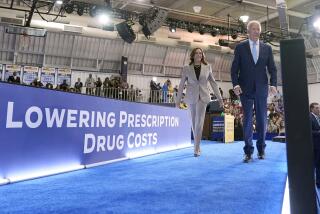Drug Price Cuts: Mystery Solved
- Share via
Sav-on Drugs, according to banners in store windows, has “lowered thousands of prescription prices.”
But when we called Sav-on Drugs headquarters to find out exactly how many thousands of drugs have lower prices, we got a big surprise. Terry Maloy, vice president for advertising and sales, sent us a fax saying that the Chicago-based unit of American Stores has actually reduced prices on only 100 of the best-selling drugs. Later, he told us the company had lowered prices on 300 drugs.
How do a few hundred price reductions translate into thousands? Through the magic of double-counting.
Maloy said that the price customers pay for prescriptions depends on how many pills are in the bottle. The price of a 10-day supply of a beta-blocker, for example, is different from that of a 30-day supply. Thus, those are counted as two reduced prescription prices. “What we’re saying is that for each prescription, the price is lower,” Maloy said.
How much lower? The company isn’t saying. Maloy said he can’t discuss price reductions or even the drugs involved for competitive reasons. A Sav-on pharmacist told us that the reductions ranged from “a few cents to a couple dollars” on drugs used to treat conditions such as heart disease, high blood pressure, ulcers and diabetes.
*
No contest: People entering Mobil’s “Going Places” sweepstakes are mostly going nowhere.
To enter, Mobil credit card holders must dial a special 800 number and listen to a recorded sales pitch for “Buyers Advantage” protection insurance for purchases made with credit cards or cash. Only after the windy pitch ends do people learn whether they’ve won--or lost.
As with most sweepstakes, losers are everywhere. Of Mobil’s more than 6 million gas card holders, only two can win either a trip to Walt Disney World or a Caribbean cruise. Fifty others will get cassette players, worth $20 apiece.
The real losers may be those who take the $49-a-year purchase protection insurance. A customer service representative for “Buyers Advantage” says the insurance extends a manufacturer’s warranty for two years--essentially the same type of insurance that many people already have on purchases made with Visa or MasterCard.
*
You don’t have to be best to be first: Strong Government Securities Fund boasts it has the “No. 1 ranking.” The Kaufmann Fund brags it has been the “No. 1 performing mutual fund” for the last five years. Neuberger & Berman Management Inc. proclaims that it has four “No. 1 ranked funds.”
Is this a six-way tie? Not exactly. How a mutual fund is ranked depends on how it defines the competition.
Take the Kaufmann Fund. In ads now appearing in Money magazine, it claims the highest five-year cumulative return among 1,245 mutual funds tracked by New York-based Lipper Analytical Services. What Kaufmann fails to mention is that for 1992, its ranking was No. 443.
Strong uses the same five-year cumulative-return gimmick to claim first place among government funds. According to Lipper, Strong wasn’t the No. 1 government fund in 1992, either.
Neuberger & Berman Management uses another gimmick, narrowing the competition to only a handful of funds of the same asset size. When the competition is broadened, Neuberger & Berman’s funds don’t rank as highly.
For example, the firm claims that in 1992, its Partners Fund was first among “growth funds with assets between $750 million and $1 billion.” There are only 13 funds with that amount of money invested. When the picture is widened to include all 305 growth funds tracked by Lipper, Partners is in 19th place. A good showing, but not No. 1.
*
Odds and ends: Kodak is giving free cameras to women who give birth on Mother’s Day, figuring new moms will probably buy lots of film. . . . Northwest Airlines and General Motors are giving new meaning to the term “park and ride.” Anyone who buys a Chevrolet Caprice before June 30 qualifies for two free tickets to anywhere Northwest flies.
More to Read
Inside the business of entertainment
The Wide Shot brings you news, analysis and insights on everything from streaming wars to production — and what it all means for the future.
You may occasionally receive promotional content from the Los Angeles Times.










